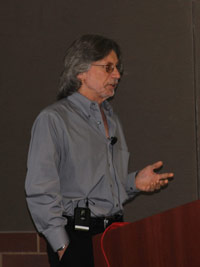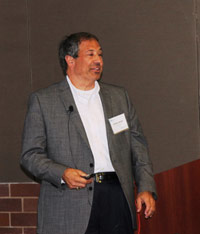
energy efficiency of our products.”
Policy makers, manufacturers, utility representatives and academic researchers joined forces last week at Calit2 to learn from each other in an attempt to advance energy efficiency measures in the rapidly growing plug load sector of electricity use.
The Emerging Technologies Coordinating Council sponsored the day-long meeting, which was held in conjunction with the CalPlug Center housed at Calit2. The event focused on policy drivers, emerging technologies, market opportunities and industry initiatives that impact the future of plug loads.
The goals were education and collaboration. “Hopefully we will be in a better position to bring new products to market for our customers,” said Edwin Hornquist, Southern California Edison emerging technologies program manager. “We want to initiate a conversation around the question of how we can be effective partners in introducing these technologies to the market.”
Featured speakers included California Energy Commission advisor Patrick Saxton; Larry Tabizon, SCE plug load and appliance program manager; and CalPlug Director G.P. Li. They were joined by three industry veterans: Vizio co-founder and Vice President Ken Lowe, Microsemi Chief Technology Officer Jim Aralis, and Tricklestar founder/CEO Bernard Emby.
Saxton, the advisor to California Energy Commissioner Andrew McAlister, said the underlying driver for most ongoing energy efficiency efforts is AB 32, legislation that requires the reduction of greenhouse gas emissions to 1990 levels by 2020.

That policy goal led to a strategic plan, which in turn, is building bridges between academia and industry, he said. “This gets business folks to think about the work many of you [at the university] have been engaged in for years.”
Electricity consumption is projected to continue its march upward, thanks to population growth, an improved economy and increased use of plug load devices. “We can dramatically flatten those curves if we adopt… achievable energy efficiency,” Saxton said. “We’re going to have to reduce carbon on the supply side of the electricity system and reduce consumption on the demand side as well.”
CalPlug’s Li gave the group an overview of the research center’s projects and capabilities, including the smart energy displays, 5W5s device sleep solution, medical and healthcare devices, bench-top testing, and simulation labs. “We want to work together to come up with an energy efficient society,” Li said, and “deliver energy efficient products to the hands of the users.”

often that power is used.”
He discussed the explosion in plug-load devices over the past decade, saying the trend will continue. In addition to our personal communication and entertainment devices, “there are more than 4,000 medical and healthcare devices out there and we haven’t discussed the energy needs of those yet.
“As we continue to want to improve our quality of life, there will be more and more devices used in this category. I think we need to be prepared. We have to figure out a way to create energy-efficient plug-load devices.”
Lowe, who co-founded TV manufacturer Vizio, told the audience that a big problem with energy efficiency is its lack of sex appeal. “Our company has always tried to improve the energy efficiency of our products, and we try to make them sexy so the energy efficiency goes hand in hand with the sexy Vizio TVs,” he said to laughter.
Lowe added that the company’s philosophy is to make the “best TVs in the world,” then drive their price down so people can afford them, while also reducing their energy usage requirements.
One approach is LED backlighting, Lowe said, which uses less power and, because there is no mercury, makes recycling easy. All of the company’s current models use a direct array configuration, which is more efficient and allows for automatic dimming, another energy saver.
Lowe is proud of his company’s decision to include Internet connectivity in its TVs because it eliminates the need for an extra (energy-consuming) device, like ROKU or Apple TV. In the first quarter of this year, 75 percent of Vizio TVs purchased were Internet models and Lowe hopes to reach 100 percent in the near future. “If we can get there, that means consumers don’t need other devices. And when you turn the TV off, that [function] turns off too, so we’re saving energy. I feel really good about that.”

Microsemi’s Aralis said his company manufactures semiconductors, high-powered switching devices and systems; power is always a consideration. “We’re working to build products, technologies and capabilities that help to locate the sources of power and efficiently extract and convert that for use in homes,” he explained.
The quantity of power used is not the sole consideration, however. “It’s not just how much power, it’s how often that power is used,” Aralis cautioned.
Microsemi also builds solar components, radio-frequency and radar devices, and field-programmable gate array integrated circuits, all of which require load-processing capabilities, and it’s not always obvious which approaches to saving energy are best. “For a very efficient, very low-power sleep mode you might want the fastest processor that burns a lot of power. You have to analyze the best course to take.”
Tabizon gave the audience the utility-side perspective. The challenge in designing plug-load energy efficiency incentives is the dearth of cost-effective measures, and unforeseen changes in the market, like the explosion of cell-phone chargers and second refrigerators. “We plan many years in advance. That makes it difficult to understand what is actually out there and what will be out there when the time comes to implement the programs,” he said.
Another challenge is a wide range of constituents. “I work with retailers, manufacturers and contractors, and each one has a different set of variables that we need to work under. So we need to work individually with each to offer incentives,” he told the audience.
The answer lies in accurate and timely planning of future technologies and trends. “Today is a perfect example of what we should be doing for our next planning cycle,” Tabizon summarized.
Tricklestar’s Emby says his company produces advanced power strips used by more than 30 utilities and efficiency programs nationwide. Because the plug load category is very diverse, both in its range of products and the problems it faces, “there is no one-size-fits-all, silver-bullet solution.”
Plug-load and advanced power strips are not well understood by consumers, Emby said, and pedaling plug-load solutions in retail markets is difficult.
The involvement of utility companies and energy efficiency programs is essential to foster education, adoption and ultimately, market transformation, he said, and more third-party-funded, quantitative research is needed.
Important considerations include: cost vs. amount of savings, device-level improvements vs. external solutions, and user trade-offs.
“Is it worthwhile to spend $5 to save $10 worth of energy, or are we spending $10 to save $1 worth of energy?” he said. “And a negative user experience usually results in very low persistence of energy savings. The overall impact on user experience should be minimal and unobtrusive.”
Emby said it’s essential to design products for a wide range of customers and to always keep things simple. “There is a broad range of technologies out there and a broad range of consumers,” he said. “We have to find the particular niches that make sense.”
Tricklestart is moving towards alternative sensing and control technologies, including light-level sensing, scheduling and countdown timers, and soft-switching capabilities.
“As the market continues to shift we have to adapt our products,” he explained. “What’s technically possible versus what makes sense?”
Presentations were followed by group question-and-answer sessions. After a lunch break, participants attended break-out sessions on technology, implementation and policy, which allowed for further sharing of ideas, and then toured the CalPlug Center.
“It was an education and productive day,” said Li. “The tremendous growth that we’re anticipating in the plug-load area means it’s essential that we work together like this to try to find solutions.”
— Anna Lynn Spitzer
